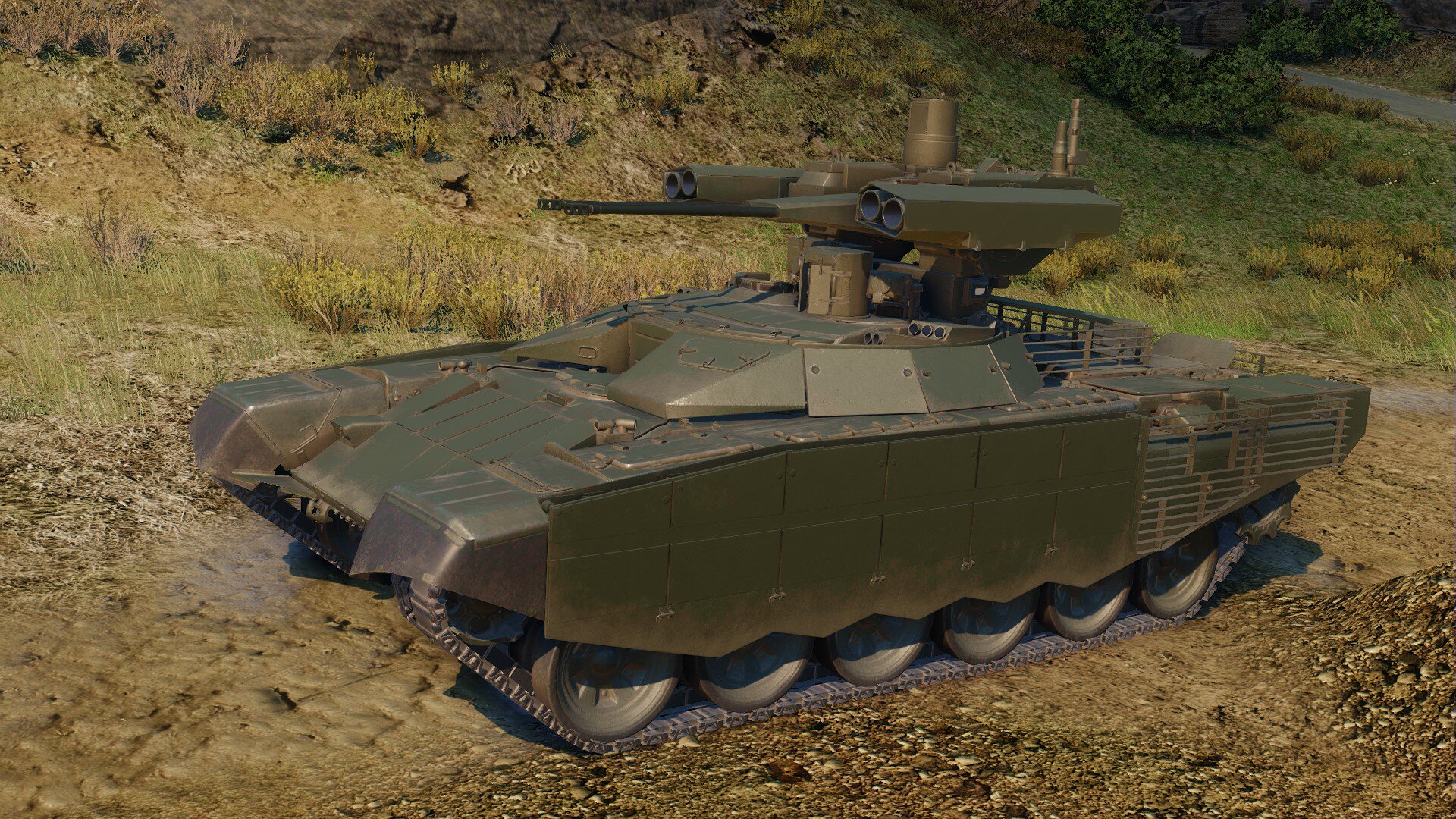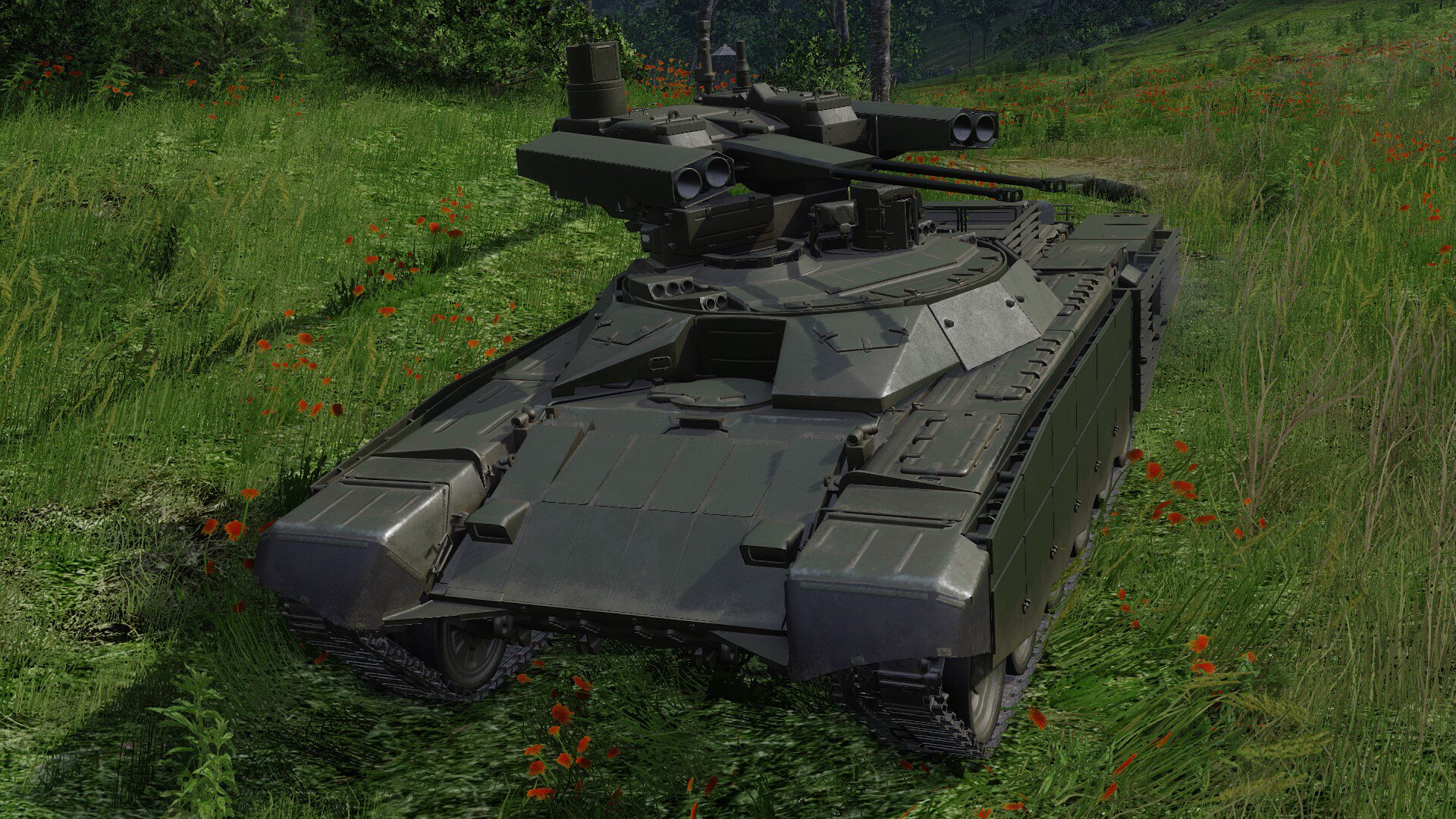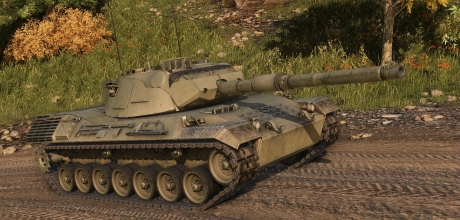
Commanders!
As its name suggests, the BMPT-72 Terminator-2 is an evolution of the original BMPT Terminator – with one twist: it uses the chassis of a T-72 instead of a T-90/T-90A.
The BMPT-72 was first shown to public during the Russia Arms Expo-2013 event in Nizhny Tagil in September 2013 but to understand where it came from, we have to go back to 2005-2006 when the Russian Army finished the official tests of the original BMPT (the first prototypes of which were shown to public as early as in 2000). It was around that time the vehicle first received the nickname “Terminator”, given to it not by its developers, but by military journalists who have been thoroughly impressed by its appearance.

The initial tests were successful and the commander of the Russian ground forces, General Aleksei Maslov, announced in June 2010 that Russia would be buying 10 Terminators. What followed was a turn of events where Maslov’s statement was retracted and the program was officially closed the same year. This decision wasn’t, however, as random as it seemed. By that time, the BMPT program was over two decades old with multiple design teams participating in it, one after another. The Russian military doctrine changes that were implemented after the fall of the Soviet Union threw the entire concept into a state of chaos with the military demands on the vehicle changed multiple times over the years with the Uralvagonzavod chief designer Vladimir Domnin admitting in 2002 that he had absolutely no idea how the vehicle would be used tactically as that was a question for a military expert.
This wasn’t really a surprise. In fact, in 1985, the BMPT was first intended as a “heavy IFV” for 7 crewmembers where plan was for a portion of the crew to disembark and act as infantry. The vehicle was supposed to operate as a part of already deployed tank formations, but not necessarily defend them directly. Shortly afterwards, the goals shifted for the BMPT to become a true support vehicle for tanks with multiple weapon systems being able to engage many types of targets in multiple directions with the focus on forward-facing firepower.
With the fall of the Soviet Union did the vehicle concept change once again with the crew being gradually reduced to 5 men and no longer expected to disembark, a step that further diminished the intended multi-directional fire ability.
But, starting from the 1990s, the war had changed with the emphasis shifting towards fighting insurgencies and various terrorist groups. The Russians got their own taste of this new type of conflict in Afghanistan and later in Chechnya and the focus of the BMPT program shifted towards fighting exactly this type of enemy, at least in the minds of the vehicle designers. Starting from 2005, the T-90-based BMPT was actually openly advertised as an “anti-terrorist” vehicle.
This concept, of course, had some serious flaws that were admitted even by the BMPT’s producer, Uralvagonzavod:
- Its Fire Control System was too complex and expensive
- Its weapon composition was not exactly suitable for fighting terrorists
- Needlessly high operational range for its role (over 550km)
- Systems that were pointless in counterinsurgency or peacekeeping operations such as radiation spall liners
To address these issues and in order for the BMPT to better fit the anti-terrorist role, UVZ proposed two different vehicles with a number of simplifications.
The BKM-1 was based on an idea that during counterinsurgency operations, one needs neither high speed nor accuracy on the move, as most of the firing will be done from a standing or slowly advancing vehicle anyway, which is why you don’t need a cutting edge FCS or an advanced gun stabilizer. Instead, the vehicle should only have simple gun sights with either a primitive stabilizer or no stabilizer at all.

BMPT’s guided missiles, mostly useless against terrorists, would also be replaced by unguided S-8 rockets with the twin 30mm 2A42 autocannons staying as the vehicle’s main armament. The hull would be roughly the same as on the earlier BMPT models but with more ERA blocks on the upper side of the vehicle to protect the crew from attacks from above. The vehicle would also be equipped with a “Pelena-6” radio jammer to protect it against IED detonations. The vehicle’s fuel capacity would be reduced significantly (with the operational range dropping from 550km to 200km), making it lighter and less vulnerable (most of the fuel would be hidden behind armor). And, last but not least, the vehicle would have a dozer blade to destroy any obstacles or barricades and increasing its frontal protection at the same time.
The BMK-2 variant would be simplified even further. The original BMPT and the BKM-1 were designed with two AG-17D grenade launchers in the sides (each requiring an operator). The BKM-2 wouldn’t have these and the armor configuration was also different, at least on paper, with most of the internal fuel tanks safe behind some of the thickest armor the vehicle had.
It seems that cost reduction was the driving force behind all the changes and they did succeed to a large degree. There was just one tiny little hiccup left – the crew. Even in its simplified form, the BMPT was supposed to be operated by a 5-man crew – the problem was, the vehicles the BMPT was built around and was supposed to complement (T-90 or T-72) had 3-man crews, so even if a potential customer saved a lot of money by having Uralvagonzavod convert its old T-72s to a BMPT, there still was the unsolved question of where to get the two more men that were needed for its crew.
The first army to encounter these issues in praxis was that of Kazakhstan. In the July of 2008, it was announced that Kazakhstan would be issuing their own set of requirements for their version of the BMPT, but it was a strange and confusing affair. For one, the Kazakhs couldn’t decide what chassis they wanted to use – the modern T-90S chassis or a more obsolete T-72 chassis since Kazakhstan had plenty of old T-72 tanks back from the Soviet days. Interestingly enough, it turned out that overhauling and converting the old Kazakh T-72s would be more expensive than having the BMPTs built from scratch using the T-90S chassis. After a few more delays, a contract was signed in 2010 and in the August of 2011, three unfinished T-90-based BMPTs took part in a military parade in Astana, only to be promptly shipped back to Uralvagonzavod afterwards for proper completion. These vehicles were slightly different from the BMPT prototype introduced earlier (Object 199 “Ramka”), but not terribly so.

The Kazakhs found an interesting use for these vehicles. In order to fight various terrorist groups and other such enemies, they would deploy them together with the famous TOS-1A rocket launchers (or, as the Russians like to call it, “heavy flamethrower systems”) in mixed units. When an enemy outpost was detected, the TOS-1A vehicles would just level the entire area with a barrage while the Terminators worked as unit command posts. Afterwards, they’d move in and mop up any survivors. Several military exercises have shown this tactic to be extremely effective.
Overall, the Kazakhs liked the vehicle, praising especially its firepower, which in turn led to a major increase in interest from other countries (most notably Algiers where the vehicle was tested for the first time in the early 2013).
The Kazakhs themselves also wanted more Terminators and, in the September of 2013, signed a memorandum along with Uralvagonzavod about the future cooperation regarding the BMPT production.
And that’s where the BMPT-72 Terminator-2 comes in, because that’s what the Kazakhs wanted – a “second series” Terminator using the T-72 chassis along with a number of modifications based on the BMPT service experience.
The Terminator-2 used a number of ideas from the BKM-1 and BKM-2 projects. The first change that was requested by the Kazakhs was a crew reduction. By removing the two grenade launchers, the number of crewmembers was reduced from the original 5 to 3, finally making the vehicle compatible with the standard Russian tank crew layout.
The FCS, on the other hand, was not simplified the way the BKM projects proposed – in fact, quite the opposite. The vehicle received modern panoramic sights, the same type the T-90MS has. And, finally, the previously exposed missile tubes received a boxy cover in order to protect them from bullets and shell fragments.
In summary, what the Russians built was a BMPT weighing 44 tons with a crew of three men. The hull was a modified T-72 model with additional Relikt Explosive Reactive Armor modules in front and on the sides. The rear sides of the vehicle and the rear armor itself were protected by an anti-RPG set of cage armor. The turret only received rudimentary anti-bullet protection but it was unmanned. The crew protection was also enhanced by an additional internal spall liner from aramid weave and the vehicle was also equipped with an automatic fire suppression system and an advanced NBC protection system. Overall, the crew protection level was excellent, comparable to or surpassing that of contemporary Main Battle Tanks.
The turret was armed with two 2A42mm cannons and four Ataka guided missile launchers capable of firing:
- 9M120-1 tandem warhead missiles
- 9M120-1F thermobaric warhead missiles
The gun rate of fire is either 250-300 rounds per minute in ammo conservation mode or over 500 rounds per minute when going all out. The guns can depress to -5 degrees and elevate to +45 degrees, allowing them to also target low flying helicopters. Their maximum range (against armored targets) is approximately 2500 meters. The vehicle carries 850 rounds. The guns are fully stabilized in two planes.
The missile launchers can also depress to -5 degrees but elevate only to +25 degrees. Their maximum range is approximately 6000 meters and the hit probability at any distance is almost 100 percent, at least based on Uralvagonzavod’s promotion. They are also allegedly capable of penetrating any tank on the battlefield. Together, both weapons form a weapon system called B07S1.

Finally, there’s the engine. Potential customers can choose from two different engines – the 840hp V-84MS turbocharged diesel or the V-92S2 1000hp turbocharged diesel. The first engine gives the BMPT-72 the same properties a standard T-72 has while the second one improves its mobility to the T-90S level. A BMPT-72 prototype appeared publically for the first time on September 27, 2013 at the Russia Arms Expo-2013 event during a widely discussed show and the hopes for export were high. The highest officials from the Russian Federation, including Prime Minister Dmitry Medvedev, offered praise to Uralvagonzavod for designing such an advanced vehicle and export success hopes were high since the BMPT-72 used T-72 technology and the T-72 was one of the most widespread MBTs in the world. The most optimistic of Russian experts even suggested that the BMPT might replace classic tanks altogether – that this is what the future of tanks looks like.
The reality, as it often happens, was a bit different, but the Russians managed to score a truly big contract in the form of the Algerian Terminators. Those are somewhat modified BMPT-72s. Algiers ordered three hundred vehicles in the April of 2016 with the first vehicles allegedly starting to arrive around this time – the contract is supposed to be fully fulfilled until the end of 2019. And, of course, Kazakhstan got its ten ordered BMPTs between 2011 and 2013, although those were T-90-based (with a modernized turret). And, last but not least, Russia ordered an unknown number of Terminators in 2017 – recently released images have shown the Russian model hulls in full production, but what exactly will the Russian Terminator be like remains, for now, a mystery.
The Terminator (a modified BMPT with a T-90-based hull and a modernized turret) has also seen its first action in Syria where it was deployed in mid-2017 by the Russian expeditionary forces on the ground. Whether it has actually seen any combat is arguable, as is the question what it was doing there and who was actually operating it (likely the Syrian Arab Army), but considering the fact Syria currently a live testing area for Russian weaponry, it’s quite possible that the Terminator approved for Russian service will be much like the one shown to Bashar Assad in Syria.

In Armored Warfare, the BMPT-72 Terminator-2 is a Tier 9 Tank Destroyer. Gameplay-wise, it works exactly like its predecessor, the Tier 8 BMPT Ramka-99. It is not a subtle vehicle due to its MBT-class weight and size, but it can be absolutely devastating thanks to its ability to fire salvos of advanced Ataka guided missiles.
Apart from being an overall improvement over the Ramka-99, the Terminator-2 has one new feature – the thermobaric Ataka ATGM variant, capable of dealing incredible damage using HESH mechanics. These missiles deal damage even upon non-penetration and are especially destructive against lightly armored targets.
We’ll see you on the battlefield!








